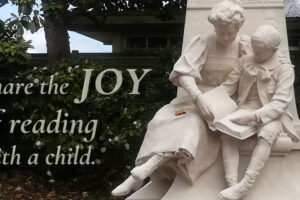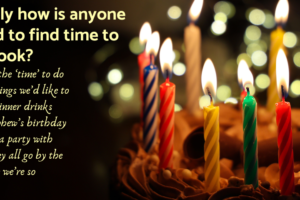Who is really going to READ your book? Do you even know?
“But, I don’t think anyone will buy my book,” they say. “Do you think anyone will buy it?”
It’s a common enough question from new or would-be writers of any books, but especially business books.
Too many authors cling to that gut-wrenching worry about sales and readers and imagine that scene they have in their mind of having a book signing where they’re standing there with their new, wonderful book in their hands, staring out at an audience of….one.
Because, yes, of course, Mom or best friend or significant other will attend, even when no one else will.
Here’s the thing: that second question they ask me, “Do you think anyone will buy it?” is a clear giveaway they’ve been true to the idea of their book, but they haven’t explored the process of becoming an author.
The better question, from my point of view as a book coach, is, “Who is your audience? Who is your message for?”
It’s Not About Fame and Fortune. It’s About People
Let’s challenge the idea of writing a book because you can’t wait to see your name on the cover – sure, being identified as the “author of” enhances expertise and gains you immediate respect – but I advise you first to understand who your reader is. Because unless you’re already famous, your name is not the part of the book that will attract readers. They’ll review the title, the subtitle, and the back cover immediately. And all of it needs to identify a problem they need you to solve.
In the greater scheme of becoming an author, you must understand who your audience is, and I don’t just mean accountants, small business owners, or teachers.
Before we delve into that, let’s discuss who is NOT going to read your book.
Here are 7 People Your Reader is Not:
- Everyone you’ve ever met who exclaimed, “You should write a book!” Unless it was me. I will read your book if I ever said I thought you should write one.
- Women as a whole. Too big of a group.
- Men. Also, too big of a group.
- Folks you met at a conference. Not as big a group as women or men, but big.
- Folks who follow you on Pinterest. Again, how big is this group? Do you really know who they are? Are there serial killers in there? (JK – I know you’re not following or being followed by serial killers.)
- Folks who follow you on Instagram. I like this group better, but you have to be specific here. You have to understand the platform to attract the right people.
- Folks who follow you on LinkedIn. Indeed, not all of them. If you have a followership, go you! But understand that they will only buy and read your book if you promote it properly.
The list could go on and on. Yes, I know your book could be appealing to all of the groups mentioned in the list, but if you go into the project expecting all of those people to buy your book because one or two of them expressed an interest, you will likely be disappointed.
Learning to understand your audience requires a drill down into: Who is this book for? Because it’s not for you.
Your book may be appropriate and interesting to:
- Everyone in the known universe. I suppose that could happen.
- Members of your many networking groups. I will expect that you have chosen said groups because their purpose complements your purpose.
- A woman or women in general. However, when you say, “My book is for women,” while you give me that squinty-eyed stare as if I’m being unreasonable to expect you to understand that women are a diverse group of people, I will stare back at you for as long as it takes you to accept that you need to identify which women, not all women.
- Men, because, well, it’s for men. It’s surely going to be just what men, as a group, are looking to read. Because men love books; just look at how many men write them.
- The book may be interesting to all of these groups, but attempting to write something to please all members of any group, men, women, or otherwise, is an exercise in futility.
All of the above applies to children and parents, also. Your book is not for all the eyeballs in the Universe, nor is it for all parents or children or known readers in the world. Remember, we are talking business books here, not fiction.

Who, then, are the people in this mysterious audience? The one you plan on selling to?
To start with, your audience must be me, or someone like me, or whomever you choose to speak to, as you write. One person or avatar you have identified as the right person for your book. You need to understand her or him, and you must create a profile describing this person.
For instance, let’s say you’re writing a book for women about the glass ceiling and how women can ignore that by becoming their own boss in their own small business. Let’s focus then on the one woman you can keep in mind, as you share your knowledge and expertise throughout your book.
- Your audience is Kim Bancroft.
- Kim lives in Pittsford, NY, a suburb of Rochester, NY.
- Kim is 29 years old and beginning to feel the usual angst at the approach of that big number 30.
- Kim is married. Her husband works at a print shop. Or her wife works at a print shop, be that specific.
- Kim is a talented event organizer. She volunteers at several non-profits.
- Kim works part-time at the local library. She loves to read! She mostly reads fiction, but she’s been toying with starting her own business, so she has recently checked out a number of business books on being an entrepreneur.
- Kim has one child, three-year-old Matthew, who seems hyperactive but is intelligent and full of laughter. He goes to daycare when she works.
- Kim is slender. Brown hair with red highlights. A warm smile. Pretty green eyes.
- Kim graduated from her local community college just last year. She took business courses. She dreams of opening a women’s boutique selling classic jewelry, clothing, and shoes.
There is more we could learn about Kim, if we were to complete the task of designing her life in this blog post. We are not going to do that, however. The goal here is to give you the building blocks of understanding your audience by developing a test subject. You are welcome to create three test subjects, but don’t try to invent a whole neighborhood. Unless you’re writing a TV show.
After you know Kim very well, write down why Kim would buy your book. Be specific.
Friends and Family and More, Oh My!
Understand that your test subjects do not live in a vacuum. They have friends and family, and many of those friends and family will be similar enough to the test subjects to be interested in your book. It’s all about who cares. Who cares about your message? Kim, and many of her friends and family, I submit.
People read to be either entertained, educated, or inspired. And I tell you it is possible to be all three in one book. Talented people are able to write books that entertain, inspire, and educate without much trouble at all. It’s all in the storytelling.
Once you have your test subjects developed and you have identified why those test subjects will buy your book, you have an audience for your book. These are your readers. These are the people you will promote your book to as it’s being written and when it launches.
Don’t forget to learn how your test subjects want the content delivered. Not everyone reads print books, anymore. Explore ebooks, print-on-demand publishing, audiobooks, and ways to deliver the content of the book in other ways.

Writing for the right audience is easy, once you know who the right audience is. If you need further guidance, help determining your audience and then keeping that message alive for them, I’m available to consult. I’ve been doing this for close to 20 years and I’ve worked with dozens of writers, just like you, so I know of what I speak.
One way I do help you understand your audience is by completing a Manuscript Review and Assessment. DM me on LinkedIn for details if you have a partially written book or a completed manuscript you would like professional eyes on. We offer a complete report and an hour-long Zoom call to discuss the report.
Or just connect and ring the ? to get daily updates of all the content I share on LinkedIn.






Leave a Reply